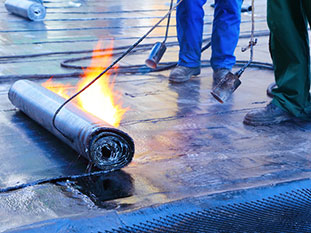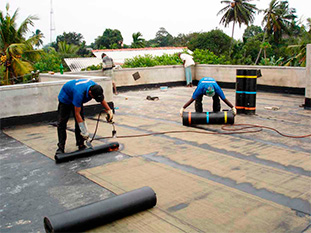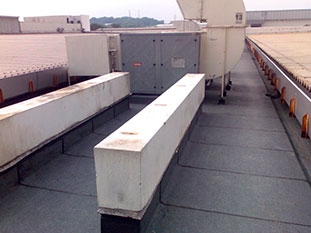Modified Bitumen Concrete Waterproofing Membrane
Product Description
Our waterproofing membranes are made of distilled bitumen modified by high molecular weight polymers and reinforced by non-woven spunbond polyester continuous fabric strands. These membranes are available in either a plain finish or impregnated with a protected surface (white or grey) made of natural slate chippings, which protects it from the harmful UV sun rays.
Roof-It also has a new line of products which are available to our customers.
Italiana Membrane S.p.A. manufactured bitumen modified membranes, thermal insulation materials laminated to waterproofing membranes, bituminous shingles, self-adhesive sealant tape, liquid products, accessories and equipment.
The plain membrane is available in 3mm thick rolls which are used together with our 4.5mm thick top sheet as a two ply (layer) waterproofing system. Alternatively, an economical one (layer) ply system can be used with the slate chips rolls. Each roll is 1 meter wide x 10 meters long. The product allows itself to flex when bonded onto surfaces that move such as steel buildings and expansion joints.
This product is ideal for waterproofing low sloped surfaces such as flat reinforced concrete roofs, walkways, rehabilitation of waterproofed coverings, foundations, underground basements walls, terraces, floors, balconies, and pools.
Application
- Our membranes are bonded onto the substrate with a bituminous primer using a propane blowtorch.
- The rolls are side lapped about 4” to form a waterproof joint and are laid perpendicular to the flow of rain water to avoid water from running along the joints.
- Surfaces are required to be properly graded using a slope of 1:60 falls and crossfalls to avoid ponding water.
- When the membrane is laid from flat to vertical areas a 45 degree angle fillet is to be constructed to avoid the membrane from bending at 90 degrees.
How to select a waterproofing membrane
- UV Stability. If the membrane is to be exposed to the sun, it must be UV resistant, otherwise it will degrade over time.
- Elongation. Measured in percentages, this refers to the ability of the membrane to stretch. Elongation is mandatory in buildings that will move, such as high-rise buildings, or buildings made with steel. This property will allow the membrane to stretch over cracks that may develop in the future.
- Tear Resistance. This is an important property, as many membranes with good elongation can still tear easily. Take a small sample of the material in your hand, and try and tear it into two pieces. This gives a fair idea of its tear resistance. You are looking for a membrane that will not tear even if a reasonable force is exerted on it.
- Chemical stability. Check that the membrane is chemically inert with respect to its environment in the building. Some membranes are not formulated to withstand harmful chemicals present in soil types e.g. outside basement walls.










